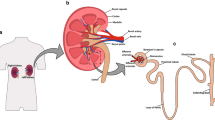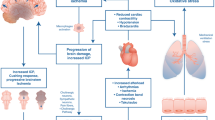Summary
Primary hepatocyte cultures have been used to evaluate data concerning hypoxic liver cell injury. To show the suitability of this method in liver preservation studies hepatocyte cultures were incubated under different conditions: warm normoxia (37°C, pO2 > 70 mm Hg), warm hypoxia (37°C, pO2 < 0.1 mm Hg), cold normoxia (4°C, pO2 > 70 mm Hg) and cold hypoxia (4°C, pO2 < 0.1 mmHg). Incubations were performed in Euro Collins solution (EC), University of Wisconsin solution of Belzer (UW) and histidine ketoglutarat tryptophan solution of Bretschneider (HTK) as well as in Krebs Henseleit buffer (KH) for control incubations. During 12 h of incubation hepatocyte cultures under warm normoxia lost viability continously in EC, UW and HTK while in KH they remained stable. Under warm normoxia all cultures lost 50% of their viability during 12 h of incubation while in cold normoxia loss of viability was mild but significant. Under cold anoxia which is the standard condition of liver preservation the cultured hepatocytes remained unchanged for 12 h in KH, UW and HTK, while in EC most of the cells were dead after 6 h. It is concluded that incubations of primary hepatocyte cultures under different pO2 and temperatures are well suited to contribute to liver preservation studies on a preclinical level and thus may help to save animal experiments.
Zusammenfassung
Primäre Leberzellkulturen haben bisher bei biochemischen Untersuchungen zum Pathomechanismus des hypoxischen Leberzellschadens Anwendung gefunden. Um die Eignung der Methode für Untersuchungen zur Leberkonservierung zu prüfen, wurden Leberzellkulturen bei normothermer Normoxie (37°C, pO2 > 70 mm Hg), normothermer Hypoxie (37°C, pO2 < 0,1 mm Hg), hypothermer Normoxie (4°C, pO2 > 70 mm Hg) and hypothermer Hypoxie (4°C, pO2 < 0,1 mm Hg) inkubiert. Bei jeder Inkubationsbedingung wurde Euro-Collins-Lösung (EC), University-of-Wisconsin-Lösung nach Belzer (UW) and Histidin-Tryptophan-Ketoglutarat-Lösung nach Bretschneider (HTK) als Inkubationsmedium verwendet; Kontrollinkubationen erfolgten in Krebs-Henseleit-Puffer (KH). Das Absterbeverhalten der kultivierten Hepatozyten zeigte während 12stündiger Inkubation einen raschen Viabilitätsverlust bei warmer Normoxie in EC, HTK and UW. In KH blieben die Zellen nahezu vollstandig vital. Bei normothermer Hypoxie starben die Leberzellen in allen Methen während der 12stündigen Inkubation zu mindestens 50% ab, während bei hypothermer Normoxie der Vitalitätsverlust deutlich verlangsamt war. Hypotherme Hypoxie schließlich zeigte in KH, HTK and UW eine nahezu vollständig erhaltene Zellviabilität ℏer 12 h, während in EC nach 6 h die meisten Zellen abgestorben waren. Durch diese Ergebnisse zeigt sich die Methode der Inkubation von primären Leberzellkulturen unter verschiedenen Sauerstoffpartialdrucken und Temperaturen als geeignet zur Evaluierung von Konservierungsmedien und ihrer Komponenten in der präklinischen Phase unter Einsparung von Tierversuchen.
Similar content being viewed by others
Literatur
Anundi L, de Groot H (1989) Hypoxic liver cell death: Critical pO2 and dependence on glycolysis. Am J Physiol 257: 658–664
Bretschneider HJ, Hübner G, Knoll D, Lohr B, Nordbeck H, Spieckermann PG (1975) Myocardial resistance and tolerance to ischemia: Physiological and biochemical basis. J Cardiovasc Surg 16:241–260
Collins GH, Bravo-Shugarman MB, Terasaki PI (1969) Kidney preservation for transplantation. Initial perfusion and 30 hour ice storage. Lancet III:1219
D'Allessandro A, Southard JH, Kayaloglu M, Belzer FO (1986) Comparison of cold storage and perfusion of dog livers on function of tissue slices. Cryobiology 23:161–167
De Groot H, Brecht M (1991) Reoxygenation injury in rat hepatocytes: Mediation by O2 −/H2O2 liberated by sources other than xanthine oxidase. Biol Chem Hoppe-Seyler 372:5–41
De Groot H, Littauer A (1989) Hypoxia, reactive oxygen and cell injury. Free Radic Biol Med 6:541–551
De Groot H, Littauer A (1988) Reoxygenation injury in rat hepatocytes: Cell death preceeds conversion of xanthine dehydrogenase to xantinoxidase. Biochem Biophys Res Commun 119:240
Donohoe MJ, Rush BF, Machiedo GW, Barillo DJ, Murphy TF (1986) Biochemical and morphologic changes in hepatocytes from the shock injured liver. Surg Gynecol Obstet 162:323–333
Gubernatis G, Pichlmayr R, Lamesch P, Grosse H, Bornscheuer A, Meyer H-J, Ringe B, Farle M, Bretschneider HJ (1990) HTK-solution (Bretschneider) for human liver transplantation — First clinical experiences. Langenbecks Arch Chir 376:66–70
Hochachka PW (1986) Defence strategy against hypoxia and hypothermia. Science 231:234–241
Jamieson NV, Sundberg R, Lindell S, Klaeson K, Moen J, Vreugdenhil PK, Wight DGD, Southard JH, belzer FO (1988) Presevation of the canine liver for 24–48 hours using simple cold storage with UW solution. Transplantation 46:517–522
Kalayoglu M, Sollinger WH, Stratta RJ (1988) Extended preservation of the liver for clinical transplantation. Lancet 1: 617–619
Lund P, Wiggins D (1988) Preservation of hepatocyte suspensions at 4°C. Transplantation 46:563–565
Michalopoulos G, Pilot HC (1975) Primary culture of parenchymal liver cells on collagen membranes. Exp Cell Res 135:431–435
Pichlmayr R, Bretschneider HJ, Kirchner E, Ringe B, Lamesch P, Gubernatis G, Hauss J, Niehaus KJ, Kaukemüller J (1988) Ex situ Operation an der Leber. Eine neue Möglichkeit in der Leberchirurgie. Langenbecks Arch Chir 373:122–126
Seglen PO (1976) Preparation of isolated rat liver cells. Cell Biol 13:29–83
Sies H, Ackerboom TPM, Tager JM (1977) Mitochondrial and cytosolic NADPH systems and isocitrate dehydrogenase indicator metabolites during ureogenesis from ammonia in isolated rat hepatocytes. Eur J Biochem 72:301–307
Southard JH, Van Gulik TM, Ametani MS, Vreugdenhil PK, Lindell SL, Pienaar BL, Belzer FO (1990) Important components of the UW solution. Transplantation 49:251–257
Todo S, Nery J, Yanaga K, Podesta L, Gordon R, Starzl TE (1989) Extended preservation of human liver grafts with UW solution. JAMA 261:711–714
Author information
Authors and Affiliations
Rights and permissions
About this article
Cite this article
Viebahn, R., de Groot, H., Lauchart, W. et al. Primäre hepatozytenkulturen als modell zur experimentellen untersuchung der leberkonservierung. Langenbecks Arch Chir 376, 268–272 (1991). https://doi.org/10.1007/BF00188266
Received:
Issue Date:
DOI: https://doi.org/10.1007/BF00188266




